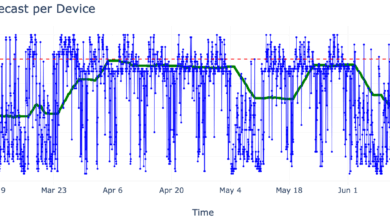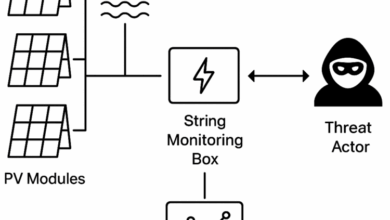The Dark Side of Black Friday: When Ransomware Attacks Join the Shopping Rush
When Shoppers Line Up, So Do Cybercriminals
As retailers gear up for the year’s biggest sales, cybercriminals are preparing for their own “Black Friday rush.” They’re not after TVs, they’re after data.
Last year, phishing surged more than 600% during Black Friday week and ransomware attacks rose nearly 60%. The holiday chaos creates perfect camouflage, but complexity is what really opens the door – retail networks are often built from multiple tools that don’t work well together, so alerts get lost and visibility drops just when attackers strike.
This season, as customers rush for deals, attackers will be doing the same. The question is: Who’s better prepared for the chaos?
Why Black Friday Creates the Perfect Storm for Ransomware
Black Friday overwhelms more than just checkout lines, it overwhelms defenses. We’ve all seen the videos – the rush when doors open at Best Buy and a hundred people sprint toward the last PS5. That same kind of chaos happens inside retail networks: systems flooded with traffic, alerts piling up faster than anyone can read them, and security teams trying to keep control while everything’s moving at once.
Retailers face a triple threat:
- Volume overload. When millions hit the checkout, malicious activity gets lost in the noise. A login from an unfamiliar IP? Probably just another shopper… until it’s not.
- Human strain. Overworked IT teams focus on uptime, not subtle threats buried in logs.
- High stakes. Every minute of downtime means lost sales and furious customers, making ransom payments sound like the quickest fix.
When the Sale Turns Sour: A Real-World Retail Attack
During Black Friday week 2024, attackers spun up fake Walmart, Target, and Best Buy sites so convincing, they fooled both shoppers and staff. Phishing spiked 2,000%1, and one bad click let ransomware sweep through payment systems and store networks, freezing checkouts and leaking customer data. IT spent the rest of the season in crisis mode.
The pattern was clear: holiday season = hacker season. It’s when everyone, from consumers to cashiers, is too busy to double-check that “free shipping” link.
It’s a lot like Home Alone – everyone’s distracted by the holiday rush while the crooks plan their move. Unfortunately, there’s no Kevin McCallister rigging traps in your data center.
Ransomware Trends Hitting Retail Hard
Ransomware has evolved. Today’s attacks steal data first and threaten to leak it if you don’t pay. This double extortion game has become the new standard.
Ransom demands are also climbing fast, averaging more than $250,000 per hit2 in 2025. Attackers know every minute of downtime during Black Friday costs retailers millions, and they use that pressure to their advantage.
Even after payment, recovery is rarely clean. Files fail to decrypt, data goes missing, and some attackers come back for more.
Traditional Security: A Patchwork That Can’t Keep Up
The problem isn’t that retailers don’t have security: they’re drowning in it – a mess of disconnected tools trying to talk to each other.
This fragmented setup leads to:
- Reactive defenses that detect breaches after damage is done
- Complex management, where visibility gaps hide critical threats
- Limited coverage across cloud, remote, and hybrid environments
In short, it’s like having a dozen locks on your front door, but the window’s still open.
Why Modern SASE Is a Must-Have Defense for Retailers
Enter Secure Access Service Edge (SASE) – a modern framework that unifies networking and security in the cloud. And Cato’s approach to SASE isn’t just an upgrade; it’s a reset.
Where legacy systems react, Cato prevents. Where others complicate, Cato simplifies. And while traditional tools struggle to scale, Cato is built for global, high-traffic retail environments.
Here’s how Cato keeps ransomware from ruining the sales season:
Global and Unified Threat Prevention
Cato unifies IPS, SWG, NGAM, and AI-driven detection to block ransomware across all traffic, from branch to cloud, on one platform with real-time visibility. And because Cato inspects all traffic inline at every PoP through its Single Pass Cloud Engine (SPACE), security stays consistent everywhere, without the gaps and blind spots that come from juggling point products.
Zero Trust Network Access (ZTNA)
Limits lateral movement by enforcing least-privilege access so users and vendors reach only what they need. With Cato’s Universal ZTNA, the same access policy applies everywhere – on-site or remote, employee or contractor, managed device or BYOD, without introducing new tools or complexity.
AI-Driven Incident Detection and Response
Cato’s XOps layer (XDR + AIOps) doesn’t just alert you, it acts. It identifies threats and helps you investigate and remediate them before ransomware can spread. The process is quick and easy: all from within Cato’s single pane of glass and with one-click mitigations for common fixes.
Safe TLS Inspection
TLS Inspection causes many applications to break, creating a real headache for administrators and discouraging them from using this vital security technique. Unlike traditional tools, Cato’s Safe TLS Inspection knows exactly which applications can be scanned without causing breakage. It gives you visibility into encrypted threats while keeping critical apps stable – real security, without the outages and trial-and-error that plague other platforms.
Stay Ahead of the Attackers
Every year, Black Friday reminds us how fast retail moves. This year, let it also remind you how fast cybercriminals adapt. Before the next big shopping wave hits, assess your ransomware defenses.
They say complexity is security’s worst enemy. But when you’ve got a complete, single security platform, AI tools and one pane of glass to see and secure it all, you’re not reacting to ransomware, you’re outrunning it.
Connect with Cato to learn how to secure your retail network before the next rush hits.
1Darktrace Reports 692% Surge in Black Friday Cyber Scams, Cyber Magazine, December 04, 2024
2Financial Cybersecurity Statistics for Black Friday and Cyber Monday 2025: What the Numbers Reveal, Coinlaw, June 16th 2025
The post The Dark Side of Black Friday: When Ransomware Attacks Join the Shopping Rush appeared first on Cato Networks.


